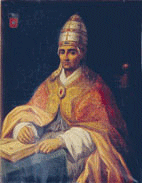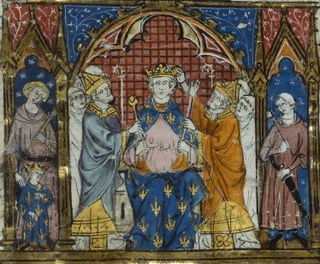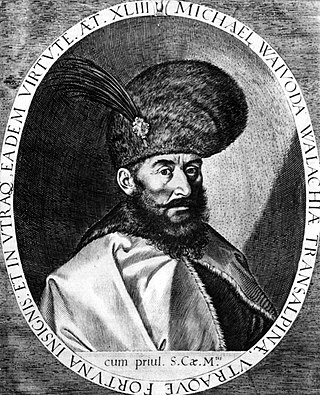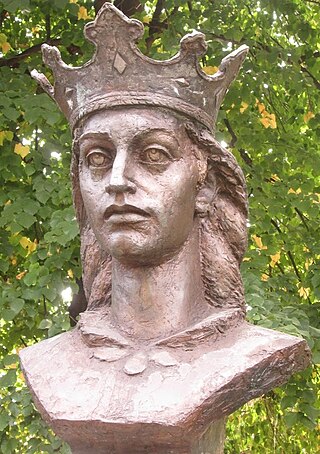Related Research Articles
The 1350s was a decade of the Julian Calendar which began on January 1, 1350, and ended on December 31, 1359.
The 1360s was a decade of the Julian Calendar which began on January 1, 1360, and ended on December 31, 1369.
The 1440s decade ran from January 1, 1440, to December 31, 1449.
Year 1475 (MCDLXXV) was a common year starting on Sunday of the Julian calendar.

Year 1342
Year 1377 (MCCCLXXVII) was a common year starting on Thursday of the Julian calendar.
Year 1383 (MCCCLXXXIII) was a common year starting on Thursday of the Julian calendar.
Year 1443 (MCDXLIII) was a common year starting on Tuesday of the Julian calendar.

Year 1317 (MCCCXVII) was a common year starting on Saturday of the Julian calendar.

Basarab I, also known as Basarab the Founder, was a voivode and later the first independent ruler of Wallachia who lived in the first half of the 14th century. Many details of his life are uncertain. Although his name is of Turkic origin, 14th-century sources unanimously state that he was a Vlach (Romanian). According to two popular theories, Basarab either came into power between 1304 and 1324 by dethroning or peacefully succeeding the legendary founder of Wallachia, Radu Negru, or in 1310 by succeeding his father, Thocomerius.

John V Palaiologos or Palaeologus was Byzantine emperor from 1341 to 1391, with interruptions.

John VI Kantakouzenos or Cantacuzene was a Byzantine Greek nobleman, statesman, and general. He served as grand domestic under Andronikos III Palaiologos and regent for John V Palaiologos before reigning as Byzantine emperor in his own right from 1347 to 1354. Deposed by his former ward, he was forced to retire to a monastery under the name Joasaph Christodoulos and spent the remainder of his life as a monk and historian. At age 90 or 91 at his death, he was the longest-lived of the Roman emperors.

Nicholas Alexander, was a Voivode of Wallachia, after having been co-ruler to his father Basarab I.

Vlad IV Călugărul was the Prince of Wallachia in 1481 and then from 1482 to 1495.

Michael the Brave, born as Mihai Pătrașcu, was the Prince of Wallachia, Prince of Moldavia (1600) and de facto ruler of Transylvania. He is considered one of Romania's greatest national heroes. Since the 19th century, Michael the Brave has been regarded by Romanian nationalists as a symbol of Romanian unity, as his reign marked the first time all principalities inhabited by Romanians were under the same ruler.

Vlad VI of Wallachia was the voivode (prince) who ruled Wallachia between June 1530 and September 1532. He has been historically referenced as Vlad Înecatul, as a description of the manner of his death.

The fall of Gallipoli was the siege and capture of the Gallipoli fortress and peninsula, by the Ottoman Turks, in March 1354. After suffering a half-century of defeats at the hands of the Ottomans, the Byzantine Empire had lost nearly all of its possessions in Anatolia, except Philadelphia. Access to the Aegean and Marmara seas meant that the Ottomans could now implement the conquest of the southern Balkans, and could advance further north into the Serbian Empire and Hungary.

The Capetian House of Anjou, or House of Anjou-Sicily, was a royal house and cadet branch of the direct French House of Capet, part of the Capetian dynasty. It is one of three separate royal houses referred to as Angevin, meaning "from Anjou" in France. Founded by Charles I of Anjou, the youngest son of Louis VIII of France, the Capetian king first ruled the Kingdom of Sicily during the 13th century. The War of the Sicilian Vespers later forced him out of the island of Sicily, which left him with the southern half of the Italian Peninsula, the Kingdom of Naples. The house and its various branches would go on to influence much of the history of Southern and Central Europe during the Middle Ages until it became extinct in 1435.
The founding of Wallachia, that is the establishment of the first independent Romanian principality, was achieved at the beginning of the 14th century, through the unification of smaller political units that had existed between the Carpathian Mountains, and the Rivers Danube, Siret and Milcov.
The Byzantine civil war of 1352–1357 was an armed conflict resulting from and following the Byzantine civil war of 1341–1347. The war pitted Byzantine emperor John V Palaiologos against John VI Kantakouzenos and his eldest son Matthew Kantakouzenos. John V emerged victorious as the sole emperor of the Byzantine Empire, but the destruction brought about by the civil war left the Byzantine state in ruins.
References
- ↑ Titsingh, Isaac, ed. (1834). [Siyun-sai Rin-siyo/Hayashi Gahō, 1652], Nipon o daï itsi ran; ou, Annales des empereurs du Japon. Paris: Oriental Translation Fund of Great Britain and Ireland, pp. 302
- ↑ University of Cambridge (6 March 2019). "Notice by the Editor". Cambridge University Reporter. 149 (Special No 5): 1. Retrieved 20 March 2019.
- ↑ Nicolle, David; Hook, Adam. Ottoman Fortifications 1300-1710. Osprey Publishing, 2010. Accessed 3 Sept 2011.
- ↑ Bowman, John Stewart, ed. (2000). Columbia chronologies of Asian history and culture. New York: Columbia University Press. pp. 39. ISBN 978-0231500043. OCLC 51542679.
- ↑ "Clement VI | pope | Britannica". www.britannica.com. Retrieved August 20, 2022.